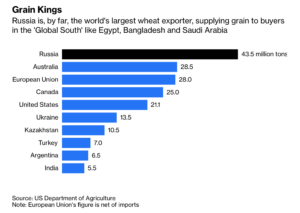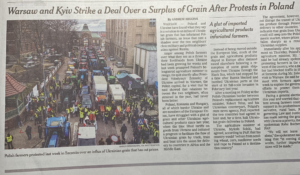As 2026 ushers in a fresh start, agricultural economists say the U.S. farm economy has stopped sliding, but it’s far from fully healed.The December Ag Economists’ Monthly Monitor shows month-to-month…
U.S. Winter Wheat Condition Deteriorates; China-Australia Trade Tensions Ease; and Bird Flu Concerns Persist
DTN Managing Editor Anthony Greder reported yesterday that, “U.S. winter wheat condition, already the lowest in decades, dropped another point last week, USDA NASS reported in its weekly Crop Progress Report on Monday.
County precipitation ranks across the US for March 2023. Three #Texas counties had their driest March ever, while a county in Utah and a couple in Michigan had their wettest March.https://t.co/U6p3edWfcw pic.twitter.com/ApoAOJvC4W
— Denise Gutzmer (@DroughtDenise) April 10, 2023
“Nationwide, winter wheat was rated 27% good to excellent, down 1 percentage point from 28% the previous week and 5 percentage points below last year’s rating at this time of 32%.
Winter #wheat condition index scores are the lowest on record for this week of the growing season at 276. #oatt pic.twitter.com/EzWq8BAZq2
— Arlan Suderman (@ArlanFF101) April 10, 2023
“The current rating is tied with 1996 for the lowest in four decades, noted DTN Lead Analyst Todd Hultman. The crop in the top winter wheat-producer Kansas is rated only 13% good to excellent.”
5 Day Forecast for Southwest Kansas. Unseasonably warm temperatures and a high fire risk will be possible over the next several days across southwest Kansas. A cold front on Friday will bring some cooler air back into southwest Kansas for the start of the weekend. #kswx pic.twitter.com/84KbRE9WD3
— NWS Dodge City (@NWSDodgeCity) April 11, 2023
Reuters writer Naveen Thukral reported today that, “Chicago wheat futures gained more ground on Tuesday, with prices supported by the deteriorating condition of the U.S. winter crop and Russia’s threat to bypass a UN-brokered grain deal.”
Meanwhile, in a separate Reuters article today, Thukral reported that, “Australian wheat plantings are set for a strong start as better-than-expected rains in parts of the country’s grain growing regions have improved soil moisture, traders and analysts said.”
The article noted that, “Australia, the world’s No. 2 wheat exporter, produced a record crop of close to 40 million tonnes in 2022/23, providing much needed food supplies to importers hit by disruptions following the coronavirus pandemic and Russia-Ukraine war.
“Australia is expected to report record-breaking agricultural exports in the current financial year, after years of high rainfall boosted yields.”

Also with respect to Australian agricultural exports, Financial Times writer Nic Fildes reported today that, “Australia will suspend a complaint against China with the World Trade Organization after Beijing agreed to review steep tariffs on Australian barley, in the latest breakthrough that signalled the easing of trade tensions between the countries.”
The FT article pointed out that, “David Uren, senior fellow at the Australian Strategic Policy Institute think-tank, said China’s rapprochement with Australia reflected Beijing’s desire to join the Comprehensive and Progressive Agreement for Trans-Pacific Partnership, a regional trade pact, as friction with the US mounts.”
Joyu Wang reported today’s Wall Street Journal that, “China’s military wrapped up three days of exercises around Taiwan, including a swarm of jet fighters launched from one of its aircraft carriers, saying it gained experience coordinating its different forces as it encircled the self-ruled island.

“The Eastern Theater Command of the People’s Liberation Army, which oversees forces positioned closest to Taiwan, issued a statement on Monday announcing the end of the exercises, which were launched after Taiwan’s president returned from a visit to the U.S. that Beijing had loudly opposed.”
Elsewhere, Bloomberg writer Khalid Al Ansary reported yesterday that, “Iraq plans to boost its wheat output by almost 60% this year, even as it continues to rely on imports to satisfy domestic demand.
“The country is expected to produce 3.5 million tons of wheat this year, up from about 2.2 million tons last year, according to Haider Nouri, director general of Iraq’s grain board. The nation will also seek to buy at least 50,000 tons this month via tender, he said during an interview in Baghdad.”
“In recent years, the country has been purchasing wheat from three sources: the U.S., Australia and Canada,” the Bloomberg article said.
And Andrew Higgins reported in today’s New York Times that, “Poland and Ukraine have found what they say is a solution to an influx of Ukrainian grain that has infuriated Polish farmers, an issue that cast a shadow over the two neighbors’ close military and political cooperation against Russia.”

“After a meeting on Friday at the Polish-Ukrainian border between Poland’s replacement agriculture minister, Robert Telus, and his Ukrainian counterpart, Poland’s state news agency, PAP, reported that the two countries had agreed to strictly limit and, for a time, halt Ukrainian grain deliveries to Poland.”
Higgins added that, “The agreement, however, will not disrupt the transit of Ukrainian produce through Poland for delivery to other countries.”
In other news, Reuters writer Adriana Barrera reported yesterday that, “Mexican authorities announced Monday a working group will investigate the impact of genetically modified (GM) corn imports on the country’s tortillas, a national staple typically made from cornflour, amid a trade dispute with the United States.”
Also yesterday, Des Moines Register writer Donnelle Eller reported that, “Wild aquatic birds spread bird flu as they migrate across the country, infecting domestic poultry. [Chad and Sheila Larson’s turkey farm in north central Iowa] was one of 32 in Iowa, ranging from giant egg operations with millions of hens to small, backyard flocks, hit with the virus over the past year.
Iowa producers destroyed nearly 16 million turkeys, chickens and other birds, the largest state toll among a total that reached 58.7 million birds at 817 farms nationwide.
“The disease contributed to a 32% spike in egg prices last year, and the U.S. Department of Agriculture has forecast prices to climb nearly 38% this year.
“The USDA estimates the outbreak ultimately will cost the agriculture sector $670 million, with $414 million going to help replace lost farm income and another $256 million to destroy birds exposed to the disease, dispose of their bodies and decontaminate the facilities.”
Eller explained that, “In March 2022, for example, bird flu hit 51 U.S. commercial poultry operations, while just seven facilities were hit last month. In Iowa, the nation’s largest egg producer and seventh-largest turkey producer, the virus affected 10 commercial chicken and turkey operations in March 2022, but none last month.
“Still, Iowa and the U.S. have a lot of highly pathogenic avian influenza floating around, said Yuko Sato, an Iowa State University veterinarian. In 2015, the U.S. detected the virus in fewer than 100 wild birds. Over the past year, that number grew to nearly 6,500.”





